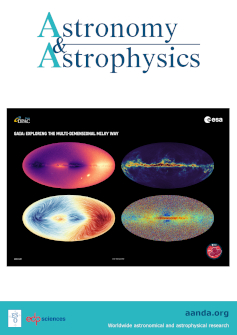Asteroid (4337) Arecibo: Two ice-rich bodies forming a binary
IF 5.4
2区 物理与天体物理
Q1 ASTRONOMY & ASTROPHYSICS
引用次数: 0
Abstract
Context. Binary asteroids are present in all populations of the Solar System, from near-Earth to trans-Neptunian regions. As is true for the small Solar System bodies (SSSBs), binary asteroids generally offer valuable insights into the formation of the Solar System, as well as its collisions and dynamic evolution. In particular, the binaries provide fundamental quantities and properties of these SSSBs, such as mass, angular momentum, and density, all of which are often hidden. The direct measurement of densities and porosities is of great value in revealing the gravitational aggregates and icy bodies that form the asteroid-comet continuum.Aims. Several observation techniques from space and ground-based platforms have provided many results in this regard. Here we show the value of the Gaia mission and its high-precision astrometry for analysing asteroid binaries and for individually deriving the masses of the components.Methods. We focus on the binary asteroid (4337) Arecibo, a member of the Themis family. We analysed the astrometry obtained in the Gaia FPR catalogue release, and performed orbital fitting for both the heliocentric orbit of the system and the relative orbit of the binary components.Results. We obtain an estimation of the component masses and their flux ratio, and derive bulk densities ρ1 ≈ 1.2 and ρ2 ≈ 1.6 for the primary and the secondary, respectively. The results are consistent with an ice-rich body in the outer main belt. They also show a significantly denser secondary or a less closely packed primary. Constraints on these densities and on macroscopic porosities are nevertheless limited by our poor knowledge of the sizes of the components. Observations of future mutual events, and of stellar occultations predicted in 2024–2025, will be essential for improving our knowledge of this system and its formation.小行星(4337)阿雷西博:两颗富冰天体形成双星
背景。双小行星存在于太阳系从近地到跨海王星区域的所有星群中。与太阳系小天体(SSSBs)一样,双星小行星通常为了解太阳系的形成、碰撞和动态演化提供了宝贵的资料。特别是,双星提供了这些 SSSB 的基本数量和属性,如质量、角动量和密度,所有这些通常都是隐藏的。直接测量密度和孔隙度对于揭示形成小行星-彗星连续体的引力聚集体和冰体具有重要价值。来自空间和地面平台的几种观测技术提供了这方面的许多结果。在此,我们展示了盖亚任务及其高精度天体测量学在分析小行星双星和单独推导各组成部分质量方面的价值。我们重点研究了双小行星 (4337) Arecibo,它是 Themis 家族的成员。我们分析了在 Gaia FPR 目录发布中获得的天体测量数据,并对该系统的日心轨道和双星成分的相对轨道进行了轨道拟合。我们估算出了双星的质量及其通量比,并得出了主星和副星的体积密度ρ1 ≈ 1.2和ρ2 ≈ 1.6。这些结果与外主带中的富冰体一致。它们还显示了一个密度明显更大的次生体或一个密度更小的原生体。然而,由于我们对这些成分的大小知之甚少,因此对这些密度和宏观孔隙率的限制是有限的。对未来的相互事件以及预计在 2024-2025 年发生的恒星掩星现象进行观测,对于增进我们对该系统及其形成过程的了解至关重要。
本文章由计算机程序翻译,如有差异,请以英文原文为准。
求助全文
约1分钟内获得全文
求助全文
来源期刊

Astronomy & Astrophysics
地学天文-天文与天体物理
CiteScore
10.20
自引率
27.70%
发文量
2105
审稿时长
1-2 weeks
期刊介绍:
Astronomy & Astrophysics is an international Journal that publishes papers on all aspects of astronomy and astrophysics (theoretical, observational, and instrumental) independently of the techniques used to obtain the results.
 求助内容:
求助内容: 应助结果提醒方式:
应助结果提醒方式:


